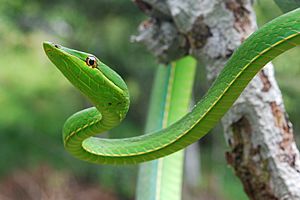Green vine snake facts for kids
Quick facts for kids Oxybelis fulgidus |
|
|---|---|
 |
|
| A green vine snake in Yasuni National Park, Ecuador |
|
| Conservation status | |
| Scientific classification | |
| Genus: |
Oxybelis
|
| Species: |
fulgidus
|
| Synonyms | |
|
|
The Oxybelis fulgidus, often called the green vine snake or flatbread snake, is a long, thin snake. It lives in trees and is found in Central America and northern South America. This snake is not related to other green vine snakes from Asia.
Contents
Common names
In South America, people call this snake by many names. Some common names are bejuca lora, bejuquilla verde, cobra-cipó, and cobra-bicuda.
Geographic range
You can find the green vine snake in many countries. These include Belize, Bolivia, Brazil, Colombia, Costa Rica, Ecuador, El Salvador, French Guiana, Guatemala, Guyana, Honduras, Mexico, Nicaragua, Panama, Peru, Suriname, and Venezuela.
Description
This snake is very thin, usually about 2 centimeters (0.8 inches) thick. It can grow to be about 1.5 to 2 meters (5 to 6.5 feet) long. Its tail is long and delicate. The snake uses its tail to hold onto branches while it reaches for food.
The snake's head is shaped like an arrow and is very pointy. Its mouth is large and goes almost the entire length of its head. The tongue is long and green. When the snake moves, it often keeps its tongue outside its mouth, moving it up and down. Scientists think the snake uses its tongue like a cat uses its whiskers. This helps it move quickly through branches.
The snake's back is bright green. Its belly and upper lip are yellowish-green. There is a thin, yellowish-white stripe along each side of its belly and tail.
Catching prey
Green vine snakes often stay high in trees, looking down for food. When they spot a mouse, lizard, or a bird's nest, they follow the prey. The snake then smells the prey carefully. If it likes what it smells, it bites the prey's head. It then lifts the prey about 20 to 40 centimeters (8 to 16 inches) off the ground. This stops the prey from fighting back.
The vine snake has two larger teeth at the back of its upper jaw. These teeth help its special saliva get into the wound. This saliva makes the prey unable to move. The snake then quickly swallows its meal. After eating, the snake usually finds a high spot in a tree to rest.
The snake's venom works fast on small animals. However, it usually has little or no effect on humans. Bites to humans are rare because the snake needs to chew to get its venom in. If a human is bitten, they might feel a slight tingling or temporary numbness. Like with all venomous animals, it's always wise to be careful when handling these snakes.
Behavior in captivity
Green vine snakes need large homes if kept by people. Their living space, called a terrarium, should be at least 2 meters (6.5 feet) tall. The floor space should be about 6 to 16 square meters (65 to 170 square feet).
When around humans, these snakes are usually calm. They often move to the other side of their terrarium. Some snakes get used to people and might even come closer. Unlike similar-looking snakes from Asia, these snakes will eat mice. Larger ones can even eat rats. This makes them popular among people who collect reptiles. In captivity, these snakes can live for about 9 to 15 years.
Images for kids
See also
 In Spanish: Bejuquilla Verde para niños
In Spanish: Bejuquilla Verde para niños








